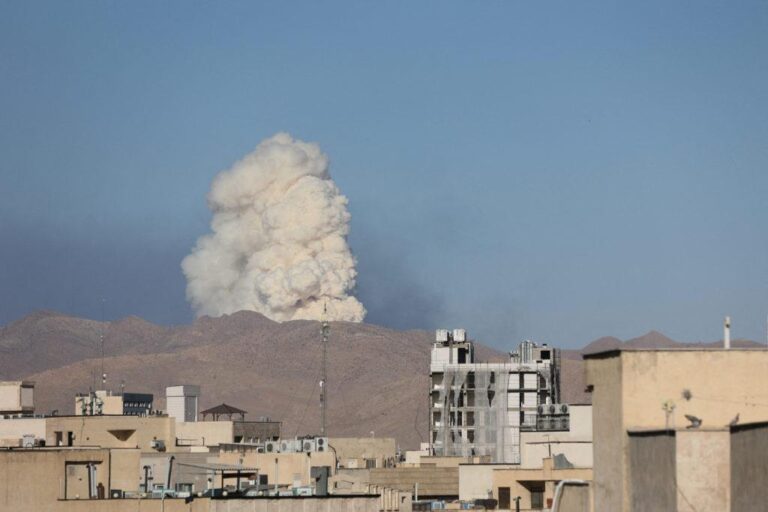In a significant escalation of regional tensions, the United States has reportedly joined forces with Israel in conducting a series of airstrikes targeting key Iranian nuclear sites, including facilities in Fordow, Isfahan, and Natanz. According to Al Jazeera, these coordinated attacks mark a dramatic development in the ongoing conflict over IranŌĆÖs nuclear program, raising concerns over potential ramifications for Middle Eastern stability and international security. This article examines the details of the strikes, the responses from Tehran and Washington, and the broader geopolitical implications of this unprecedented collaboration.
US and Israel Coordinate Strikes Targeting Key Iranian Nuclear Facilities
Recent military operations saw the United States aligning closely with Israel to execute a series of precise airstrikes on several Iranian nuclear sites. These coordinated attacks primarily targeted facilities located at Fordow, Isfahan, and Natanz ŌĆö sites long under international scrutiny for alleged nuclear enrichment activities. Sources indicate that the strikes aimed to disrupt ongoing nuclear advancements, signaling a heightened phase of intervention amid escalating geopolitical tensions in the Middle East.
The mission featured a combination of air and cyber components, leveraging advanced intelligence to minimize collateral damage. Key details uncovered in the aftermath include:
- Fordow Facility: Disruption of centrifuge operations critical to uranium enrichment.
- Isfahan Complex: Targeting of uranium conversion units and research labs.
- Natanz Site: Damage to infrastructure supporting nuclear fuel production.
Analysts suggest this coordinated approach marks a strategic shift, emphasizing pre-emptive containment of IranŌĆÖs nuclear ambitions through joint tactics and shared intelligence capabilities.
| Facility | Primary Target | Operational Outcome |
|---|---|---|
| Fordow | Centrifuges | Significant operational disruption |
| Isfahan | Conversion Units | Damage limiting further uranium processing |
| Natanz | Fuel Production | Infrastructure impairment reported |
Impact of Attacks on Fordow, Isfahan, and Natanz Sites and Regional Security Implications
The recent coordinated attacks on the Fordow, Isfahan, and Natanz nuclear sites have significantly heightened tensions in an already volatile region. These strikes, reportedly involving both US and Israeli forces, have targeted critical infrastructure believed to be integral to IranŌĆÖs nuclear development capabilities. The impact extends beyond physical damage, severely disrupting operational timelines, and degrading key components essential for uranium enrichment. Such strategic blows amplify Iran’s vulnerabilities, yet simultaneously risk pushing Tehran to accelerate its defensive posturing and retaliatory measures.
Regional security analysts warn of far-reaching consequences stemming from these assaults. Key implications include:
- Escalation risks: Increased likelihood of reciprocal attacks or proxy conflicts across the Middle East.
- Diplomatic fallout: Further deterioration in Iran-West relations, complicating negotiations on nuclear diplomacy.
- Energy market volatility: Disruptions potentially provoking spikes in global oil prices.
- Security recalibrations: Neighboring countries boosting military readiness and forging new alliances.
| Site | Damage Extent | Strategic Importance |
|---|---|---|
| Fordow | Severe | Uranium enrichment facility |
| Isfahan | Moderate | Uranium conversion plant |
| Natanz | Severe | Primary enrichment site |
Analysis of IranŌĆÖs Potential Military and Political Responses to Joint Assault
IranŌĆÖs military response is expected to be calculated yet resolute. Given TehranŌĆÖs strategic doctrine, it is likely to escalate asymmetrically, focusing on proxy forces across regional theaters and leveraging missile strikes from allied groups in Lebanon, Iraq, and Yemen. Iran’s Revolutionary Guard Corps (IRGC) may intensify drone and rocket attacks targeting US and Israeli interests, while also mobilizing cyber capabilities aimed at critical infrastructure across the adversaries’ domains. The regimeŌĆÖs demonstrated ability to maintain a network of regional influence means retaliatory attacks could be dispersed and multifaceted, complicating immediate countermeasures.
Politically, Tehran may adopt a posture blending defiance with diplomacy, projecting national resilience domestically while appealing to international forums for condemnation of what it terms ŌĆ£unlawful aggression.ŌĆØ Possible political responses include:
- Heightened rhetoric from Supreme Leader Ayatollah Khamenei and other senior officials condemning the coalitionŌĆÖs actions.
- Requests for emergency meetings at the United Nations Security Council and the Organization of Islamic Cooperation.
- Accelerated nuclear activities perceived as a political bargaining tool to pressure Western powers.
- Strengthening alliances with Russia and China for diplomatic support and technological exchange.
| Response Type | Likely Actions | Strategic Objective |
|---|---|---|
| Military | Proxy missile strikes, cyberattacks | Disrupt enemy operations, demonstrate reach |
| Political | UN appeals, forging alliances | Garner international support, reduce isolation |
| Nuclear | Accelerated uranium enrichment | Leverage negotiations, deterrence |
Recommendations for Diplomatic Engagement to De-escalate Tensions in the Middle East
To prevent further escalation in the region, it is imperative that diplomatic channels remain open and robust. Engaging Iran and its regional partners through multilateral platforms can foster dialogue and reduce misunderstandings. Emphasizing confidence-building measures such as mutual de-escalation commitments and transparency in military activities could pave the way for a more constructive atmosphere. Additionally, leveraging the influence of global powers to mediate and enforce ceasefires is crucial in halting the spiral of violence that threatens regional stability.
Key strategies moving forward should include:
- Initiating urgent talks under the auspices of the United Nations Security Council
- Promoting back-channel communications between Israeli and Iranian officials
- Encouraging regional economic and cultural cooperation as incentives for peace
- Facilitating third-party mediation by neutral countries or international organizations
Proposed Diplomatic Framework
| Step | Objective | Expected Outcome |
|---|---|---|
| Immediate Ceasefire Talks | Halt ongoing hostilities | Reduction in casualties and tension |
| Confidence-Building Measures | Establish mutual trust | Foundation for sustained dialogue |
| Long-Term Negotiations | Address underlying conflicts | Comprehensive peace agreement |
In Conclusion
The escalating military actions mark a significant intensification in the ongoing tensions between the United States, Israel, and Iran, highlighting the fragile and volatile nature of regional security in the Middle East. As international responses continue to unfold, the global community watches closely, aware that the consequences of these strikes may reshape diplomatic and strategic calculations in the months ahead. Further developments are expected as all parties involved navigate the complex and rapidly evolving situation.




